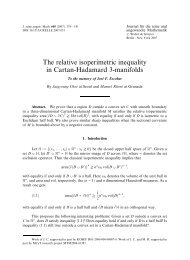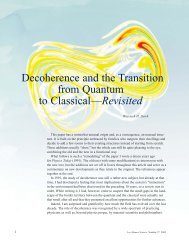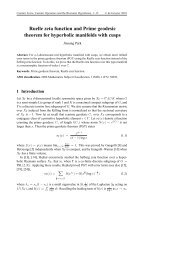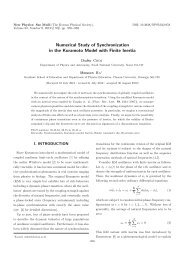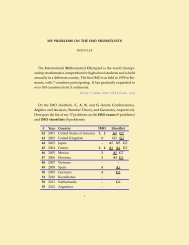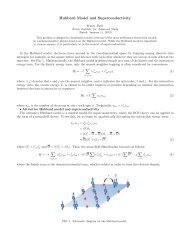A Quantum Kirwan Map: Bubbling and Fredholm Theory for ... - KIAS
A Quantum Kirwan Map: Bubbling and Fredholm Theory for ... - KIAS
A Quantum Kirwan Map: Bubbling and Fredholm Theory for ... - KIAS
You also want an ePaper? Increase the reach of your titles
YUMPU automatically turns print PDFs into web optimized ePapers that Google loves.
2.6. SOFT RESCALING 43exists. Inequality (2.44) implies that E z (ε) ≥ E min . Since E R0 (w 0 ,A(z,1/i,ε))depends continuously on ε, the same holds <strong>for</strong> E z (ε). This proves statement (iii)<strong>and</strong> completes the proof of Proposition 37.□Remark. In the above proof the set of bubbling points Z is constructed by“terminating induction”. Intuitively, this is induction over the number of bubblingpoints. The “auxiliary index” l in the claim is needed to make this idea precise.Inequality (2.44) ensures that the “induction stops”. ✷2.6. Soft rescalingThe following proposition will be used inductively in the proof of Theorem 3 tofind the next bubble in the bubbling tree, at a bubbling point of a given sequence ofrescaled vortex classes. It is an adaption of [MS2, Proposition 4.7.1.] to vortices.44. Proposition (Soft rescaling). Assume that (M,ω) is aspherical. Let r > 0,z 0 ∈ C, R ν > 0 be a sequence that converges to ∞, p > 2, <strong>and</strong> <strong>for</strong> every ν ∈ N letw ν := (A ν ,u ν ) ∈ ˜W p B r(z 0) be an R ν-vortex, such that the following conditions aresatisfied.(a) There exists a compact subset K ⊆ M such that u ν (B r (z 0 )) ⊆ K <strong>for</strong> every ν.(b) For every 0 < ε ≤ r the limit(2.56) E(ε) := limν→∞ ERν (w ν ,B ε (z 0 ))exists <strong>and</strong> E min ≤ E(ε) < ∞. Furthermore, the function(2.57) (0,r] ∋ ε ↦→ E(ε) ∈ Ris continuous.Then there exist R 0 ∈ {1, ∞}, a finite subset Z ⊆ C, an R 0 -vortex w 0 := (A 0 ,u 0 ) ∈˜W C\Z , <strong>and</strong>, passing to some subsequence, there exist sequences ε ν > 0, z ν ∈ C,<strong>and</strong> g ν ∈ W 2,ploc(C \ Z,G), such that, definingϕ ν : C → C, ϕ ν (˜z) := ε ν˜z + z ν ,the following conditions hold.(i) If R 0 = 1 then Z = ∅ <strong>and</strong> E(w 0 ) > 0. If R 0 = ∞ <strong>and</strong> E ∞ (w 0 ) = 0 then|Z| ≥ 2.(ii) The sequence z ν converges to z 0 . Furthermore, if R 0 = 1 then ε ν = Rν−1 <strong>for</strong>every ν, <strong>and</strong> if R 0 = ∞ then ε ν converges to 0 <strong>and</strong> ε ν R ν converges to ∞.(iii) If R 0 = 1 then the sequence gνϕ ∗ ∗ νw ν converges to w 0 in C ∞ on every compactsubset of C\Z. Furthermore, if R 0 = ∞ then on every compact subset of C\Z,the sequence gνϕ ∗ ∗ νA ν converges to A 0 in C 0 , <strong>and</strong> the sequence gν −1 (u ν ◦ ϕ ν )converges to u 0 in C 1 .(iv) Fix z ∈ Z <strong>and</strong> a number ε 0 > 0 such that B ε0 (z) ∩ Z = {z}. Then <strong>for</strong> every0 < ε < ε 0 the limitE z (ε) := limν→∞ EενRν( ϕ ∗ νw ν ,B ε (z) )exists <strong>and</strong> E min ≤ E z (ε) < ∞. Furthermore, the function (0,ε 0 ) ∋ ε ↦→E z (ε) ∈ R is continuous.(v) We have(2.58) lim limsup E Rν( w ν ,B R −1(z 0 ) \ B Rεν (z ν ) ) = 0.R→∞ν→∞



